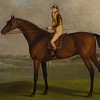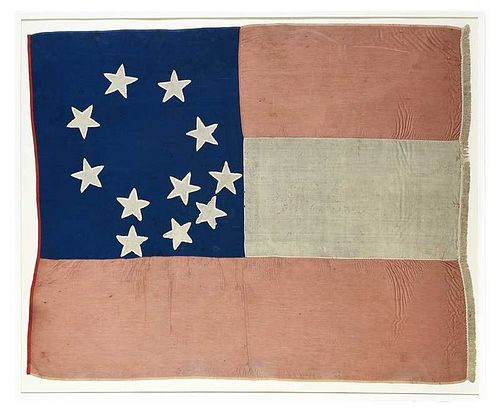Tennessee, circa 1862, a rare large scale First National flag of the Confederacy, also called the "Stars and Bars", with seven stars in a circle and four stars on the lower inside quadrant,˜ blend of silk, cotton and wool field with a fringe on the fly and the 11 stars double appliqued and edged with silk, 68 x 53 in.; recently sandwich mounted in aluminum frame with UV protective glazing, 61-1/4 x 73 in., accompanied by merchandise tag of "Hiram F. Devol/ Dealer in General Merchandise and Produce˜ stating "Captured at Ft. Donaldson? (sic) February 16, 1862", Conservation report by Heritage Conservation, extensive family history of Hiram F. Devol and historical information on the Battle of Fort DonelsonNote:˜This important flag descended in the family of Captain Hiram Fosdick Devol. Devol had a stellar military career in the 36th Ohio Infantry during the Civil War. While the 36th Ohio saw significant action in Virginia and Maryland, they were not at Fort Donelson.˜ Devol somehow obtained this rare relic from Ft. Donelson and even attached his own merchandise tag to the flag. Regardless of how this flag ended up in his family, it is a rare and desirable early captured Confederate company or regimental flag.˜Forts Donelson, Heiman, and Henry were built to prevent Union armies from using the Tennessee and Cumberland rivers to advance into the Confederate interior after Kentucky decided not to join the Confederacy.˜ General Ulysses S. Grant led the Union force to attack Fort Henry and Fort Heiman on the Tennessee river. In coordination with Grant, gunboats under the command of Flag Officer Andrew H. Foote proceeded up the river to attack the forts. In a swift, violent exchange of gunfire, Forts Heiman and Henry quickly fell to the Union gunboats on February 6, 1862.˜ Grant was determined to move quickly onto the much larger Fort Donelson, located on the nearby Cumberland River but delayed by various circumstances.˜By February 13, Grant had arranged his soldiers and blocked a landward exit for the Confederate forces. On February 14, 1862, Foote?s ironclads moved upriver to bombard Fort Donelson.˜ The subsequent duel between Foote?s ?Pook Turtles? and the heavier guns at the fort led to a Union defeat. Another setback for the Union occurred when the Confederates forced open a path of escape and drove the right flank of the Union forces back with significant losses.˜ Sensing a complete victory over the Union forces, Confederate Brig. General Gideon Pillow, ordered the attacking forces back to their earthworks, thereby abandoning the hard-fought gains.˜Grant took advantage of the retreat and ordered his right flank to retake their lost ground and then ordered the Union left to attack, thereby overwhelming the divided Confederate forces.˜ Before the Union could attack again, the Confederates surrendered. While hoping for generous terms of surrender, Grant reportedly replied ?No terms except unconditional and immediate surrender can be accepted. I propose to move immediately upon your works.? The decisive Union victories at Forts Henry and Donelson, brought acclaim to Grant?s military reputation and helped open up Tennessee to Union advances. For more information on Fort Donelson, see https://www.battlefields.org/learn/articles/fort-donelson˜The First National Flag came into existence on March 4, 1861, complying with orders from the Provisional Confederate Congress in Montgomery Alabama. The first examples bore only seven stars for each state that had seceded at the time. After the firing on Fort Sumter on April 12, 1861, four more states left with Tennessee being the last in early June 1861. As more states left, more stars were added up to thirteen stars. Besides being the first political flag for the Confederacy, it also became the first battle flag for both the Confederate army and navy. Despite being replaced by other battle flag designs, such as the more common design known as the "Southern Cross", the First National served through the end of˜ the Civil War. ˜Provenance: Hiram Fosdick Devol. Harriet Lyon (granddaughter), 1960.; James D. Julia, Fairfield, Maine, October 9, 2014, Lot 3265; Property from a Franklin, Tennessee Historic HomeNote: This important flag descended in the family of Captain Hiram Fosdick Devol. Devol had a stellar military career in the 36th Ohio Infantry during the Civil War. While the 36th Ohio saw significant action in Virginia and Maryland, they were not at Fort Donelson.˜ Devol somehow obtained this rare relic from Ft. Donelson and even attached his own merchandise tag to the flag. Regardless of how this flag ended up in his family, it is a rare and desirable early captured Confederate company or regimental flag.˜Forts Donelson, Heiman, and Henry were built to prevent Union armies from using the Tennessee and Cumberland rivers to advance into the Confederate interior after Kentucky decided not to join the Confederacy.˜ General Ulysses S. Grant led the Union force to attack Fort Henry and Fort Heiman on the Tennessee river. In coordination with Grant, gunboats under the command of Flag Officer Andrew H. Foote proceeded up the river to attack the forts. In a swift, violent exchange of gunfire, Forts Heiman and Henry quickly fell to the Union gunboats on February 6, 1862.˜ Grant was determined to move quickly onto the much larger Fort Donelson, located on the nearby Cumberland River but delayed by various circumstances.˜By February 13, Grant had arranged his soldiers and blocked a landward exit for the Confederate forces. On February 14, 1862, Foote?s ironclads moved upriver to bombard Fort Donelson.˜ The subsequent duel between Foote?s ?Pook Turtles? and the heavier guns at the fort led to a Union defeat. Another setback for the Union occurred when the Confederates forced open a path of escape and drove the right flank of the Union forces back with significant losses.˜ Sensing a complete victory over the Union forces, Confederate Brig. General Gideon Pillow, ordered the attacking forces back to their earthworks, thereby abandoning the hard-fought gains.˜Grant took advantage of the retreat and ordered his right flank to retake their lost ground and then ordered the Union left to attack, thereby overwhelming the divided Confederate forces.˜ Before the Union could attack again, the Confederates surrendered. While hoping for generous terms of surrender, Grant reportedly replied ?No terms except unconditional and immediate surrender can be accepted. I propose to move immediately upon your works.? The decisive Union victories at Forts Henry and Donelson, brought acclaim to Grant?s military reputation and helped open up Tennessee to Union advances. For more information on Fort Donelson, see https://www.battlefields.org/learn/articles/fort-donelson˜The First National Flag came into existence on March 4, 1861, complying with orders from the Provisional Confederate Congress in Montgomery Alabama. The first examples bore only seven stars for each state that had seceded at the time. After the firing on Fort Sumter on April 12, 1861, four more states left with Tennessee being the last in early June 1861. As more states left, more stars were added up to thirteen stars. Besides being the first political flag for the Confederacy, it also became the first battle flag for both the Confederate army and navy. Despite being replaced by other battle flag designs, such as the more common design known as the "Southern Cross", the First National served through the end of˜ the Civil War. ˜
Condition
full treatment report available for review, moth damage evident throughout especially in the white bar, scattered stains, repair to bottom left corner, lacking hoist ties and center hoist hole is torn,˜







